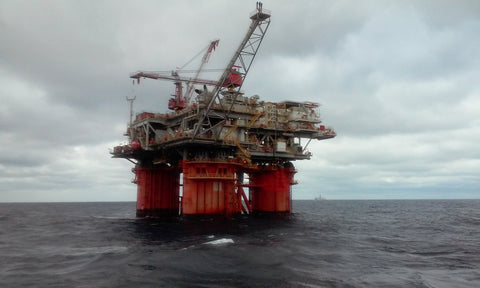All About Whales - And How To Save Them
When asked what the largest animal on Earth is, most minds go immediately to elephants, which isn’t bad considering they are a lot more represented and publicized, and they are the largest land animal. However, the largest animals that exist on the whole planet are whales. The blue whale takes the top rank weighing in at more than 400,000 pounds (about 33 elephants).

If you have ever had the opportunity to see any species of whale live, you were probably just as captivated and in awe as we are of these amazing mammals. What many do not realize though is the important role whales play in not only ocean ecosystems, but also for the entire Earth.
We are just scratching the surface of the complex species classified as whales. We want to share what we have learned about whales and the roles they play, why their numbers are continuing to decline, and how we can all be a part of protecting them.
A Whale of a Tail
Found in every ocean, whales are warm-blooded mammals that nurse their young just like dogs, cats, mice and, of course, us. Whales are classified as cetaceans, which comes from the Greek work ketos or “large sea creature”, along with the different species of dolphins and porpoises. Cetaceans are then divided into two different groups: baleen whales and toothed whales.

Baleen whales have also been called “great whales” and include blue whales, humpbacks, right whales, bowhead whales, and others. They are generally larger than toothed whales, and feed by straining smaller animals like krill through the fringed plates of long, fingernail-like material called baleen attached to their upper jaws.

Toothed whales, as the name suggests, have teeth, which are used to hunt and eat squid, fish, seals, and other animals. Toothed cetaceans include sperm whales, as well as dolphins, porpoises, and orcas. Another difference is toothed whales only have one blowhole, where baleen whales have two.
What can get a little confusing is knowing the difference between the species that make up cetaceans. So all dolphins are whales, but not all whales are dolphins. It may sound confusing, but all dolphins are simply smaller types of whales. This is because the whale order, Cetacea, is divided into several different families, one of them being Delphinidae, which includes all oceanic dolphin species. As far as telling the difference between dolphins and porpoises, there are a few distinguishing characteristics between them. Dolphins tend to have prominent, elongated “beaks'' and cone-shaped teeth, while porpoises have smaller mouths and spade-shaped teeth. Dolphins also have a hooked or curved dorsal fin while porpoises have a triangular dorsal fin. A dolphin’s body also tends to be more lean and where a porpoises’ body is rounded.

Another distinguishing characteristic of whales that is recognized by many is the way they are able to communicate. Whales “songs” have been used for a variety of movies and even music. It is baleen whales such as humpback and blue whales that communicate through a series of “songs.” They are made up of a complex combination of moans, howls, and cries that can continue for hours, and are produced when whales push air around in their heads, then amplify the sounds through a blob of fat that perches on the top jaw. Researchers believe they can be heard for thousands of miles.
Toothed whales have the ability to echolocate. They do this by emitting various clicking sounds through the water and wait for the rebounding sound waves to indicate where their prey is, as well as enhance their communication abilities between one another.
Fun fact: Some species of whales are among the longest lived mammals. Scientists estimate bowhead whales, a baleen whale found in the Arctic, can live for more than 200 years.

Whales play an important role in regulating ocean ecosystems. When whales dive deep in the ocean, they stir up nutrients from the depths below. This promotes better nutrient circulation, and supports phytoplankton at the surface of the water, which are a major food source for many fish and crustaceans. Whales also produce huge amounts of nutrient-rich feces that plants and phytoplankton use to grow. Because whales can’t “poop” under pressure, they take their bathroom breaks at the ocean’s surface and by doing so, supply phytoplankton with life giving nutrients like iron, nitrogen and phosphorus. Phytoplankton use photosynthesis to absorb nearly a third of human-generated carbon dioxide from the atmosphere which is almost as much as the amount absorbed by all land-based ecosystems like forests and rainforests. Phytoplankton in turn produce half of our planet's oxygen. So we can thank them and whales for every other breath that we take.

Even after whales die, they continue to support oceanic species in a large way. A phenomenon known as “whale fall,” is when their immense carcasses sink to the seafloor and provide an abundance of nutrients that support deep-sea life. The bodies of whales produce a feast to some 400-odd species that are sustained by the nutrients and shelter they provide. This can support marine biological communities for years, and even decades. Thus, without whales, entire marine communities would likely be affected. These great mammals provide balance in the ecosystem, and us land animals would see a huge negative impact without them on our side and in our air.
Threats to Survival
Today, whales face numerous threats. From climate change to ship strikes, hunting, and oil and gas development, whales have a ton of different factors that affect their quality of life and survival.

A big threat that many don’t realize is ocean noise pollution. Activities like offshore drilling, ship traffic, and sonar for fishing or military purposes creates a maze of sound that disorients whales. Whales are struggling to communicate with one another, hunt, and locate mates. Ocean noises cause immense physical stress for whales and in some cases, can lead to death.

Though the stark population declines from hunting have largely stopped, commercial whaling is also an unfortunate action that is continuing to happen around the world. The International Whaling Commission was established in 1946 to help regulate whale hunting and is now working to address a wide range of conservation issues. Unfortunately countries such as Iceland, Japan, and Norway continue their commercial whaling practices and over 1,000 whales a year are killed for such commercial purposes.
Many whale populations were driven to the brink of extinction during the industrial whaling era of the 19th century, including North Atlantic right whales and sperm whales, during which time almost 3 million whales were killed. Today, some populations, such as the blue whale, which was depleted by about 90%, are still struggling to recover from this extreme period of hunting. Some whale species and populations are starting to show signs of recovery, but whales are long-lived and slow breeding, and face myriad threats throughout the world’s oceans today.
Ship strikes, plastic pollution, environmental changes due to climate change, and entanglement in fishing gear continue to threaten the well-being of whales around the world.
How to Help

Dispose of your trash responsibly. - According to the United Nations Environment Program, 8 million pieces of marine debris enter the ocean every single day. This equates to 6.4 million tons of trash each year. Recycle what you can, pick up trash you find, and avoid letting balloons go. Take it a step further and plan a local beach or park cleanup with your friends and family and spend the afternoon helping to keep your city and our planet clean.

Use eco-friendly cleaning products. - All drains lead to the ocean. Eco-friendly cleaning products are made using sustainable manufacturing practices and naturally derived, safe, non-toxic, and biodegradable ingredients that don't negatively impact the environment or your family’s health. You will not only be helping reduce harmful chemical runoff, but you will be creating a better and healthier home for your family and yourself.
Say NO to plastic bags. - Plastic bags are particularly dangerous because of their resemblance to jellyfish and are estimated to kill over 100,000 birds, turtles and marine mammals each year. Keep a supply of reusable bags in your car and home that you can bring in the store with you so you are always ready. Check out our adorable variety of wildlife reusable bags here.
Support legitimate conservation organizations. - Groups like MarAlliance, the World Wildlife Foundation, and Wildlife Conservation Society are all doing amazing work to help save and conserve our oceans, planet, and the wildlife that inhabit it. Look into ways you can join their initiative including careers and volunteering. If you aren’t able to donate your time, donating financial support to allow them to continue to do what they do makes a huge difference.



